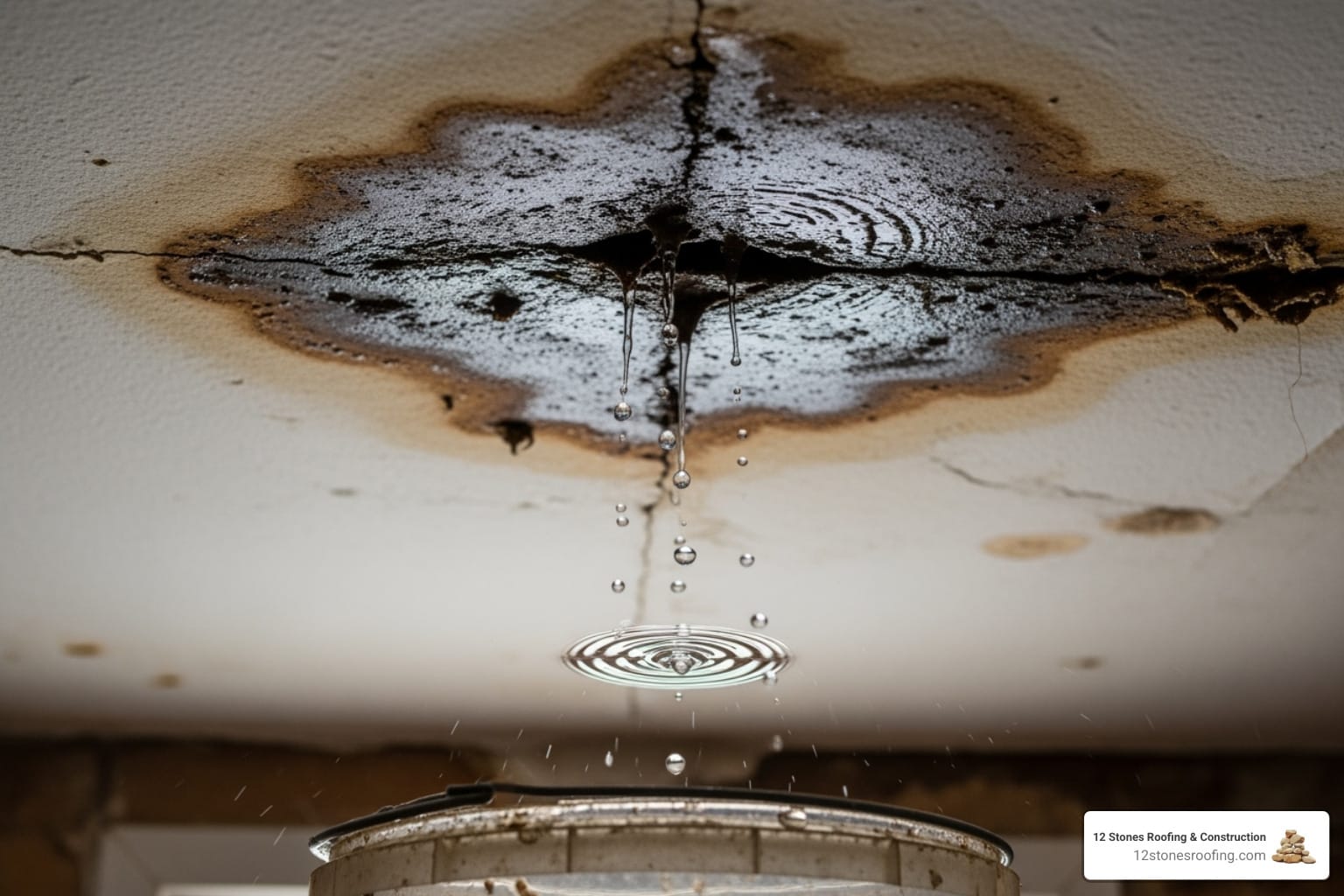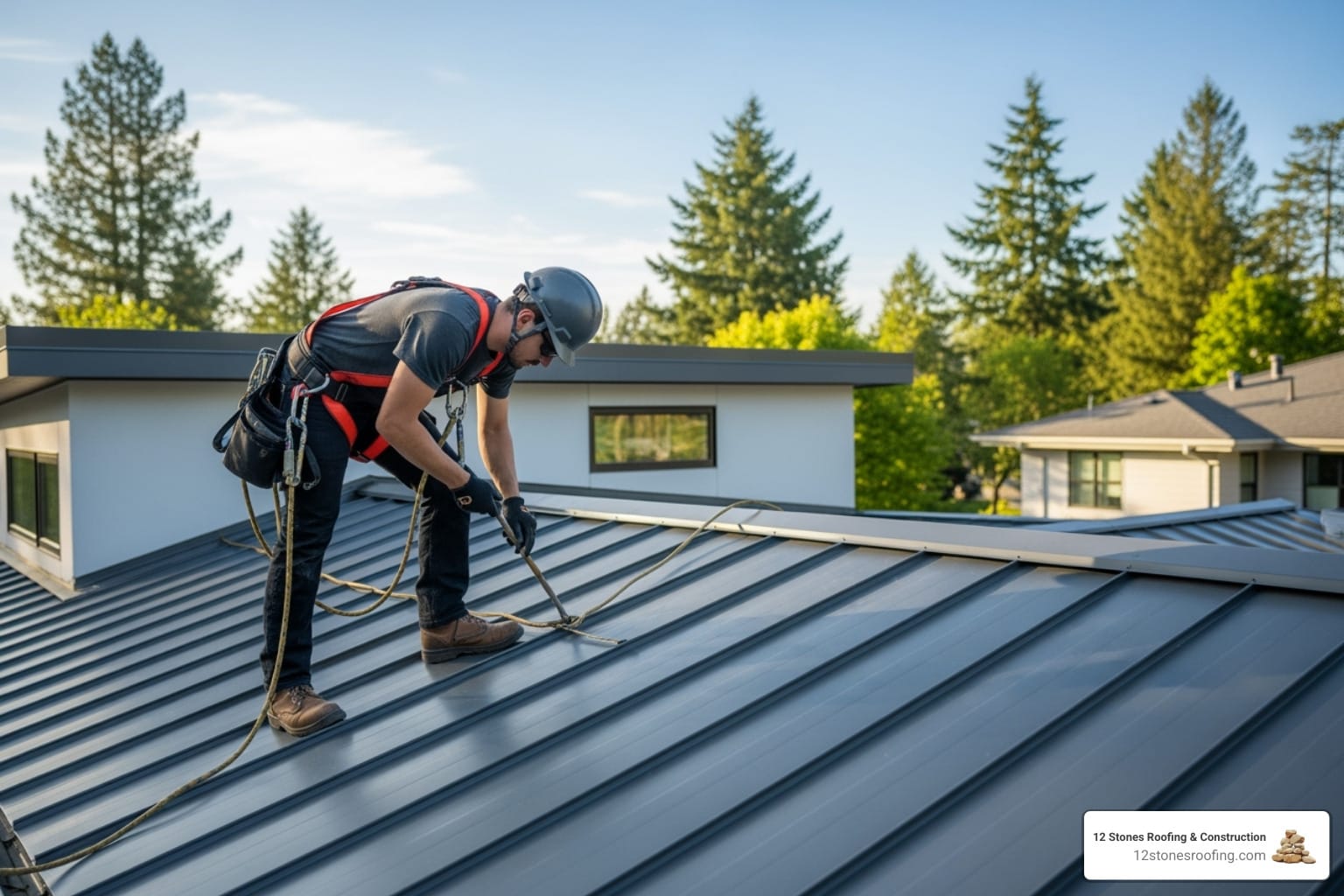Why Wind Damage Roof Replacement Matters for Pasadena Homeowners
Wind damage roof replacement is a critical decision that protects your Pasadena home from further deterioration and costly interior damage. After a severe storm, understanding whether you need a simple repair or a complete replacement—and how to steer the insurance process—can save you thousands. For homeowners in the region, working with a trusted local roofing company is the first step toward securing your property.
Quick Answer: What to Know About Wind Damage Roof Replacement
- Assess Damage Immediately: Look for missing shingles, granule loss in gutters, and interior water stains after a storm.
- Repair vs. Replace: Repair is suitable for localized damage on newer roofs (under 15 years). Replacement is necessary if damage exceeds 30%, the roof is over 20 years old, or structural issues exist.
- Insurance Coverage: Most policies cover sudden wind damage. Document everything thoroughly and file your claim promptly.
- Average Costs: Replacement costs range from $7,000 to $20,000+, depending on materials. Professional roof replacement services ensure proper installation and long-term protection.
Wind speeds as low as 40 mph can damage your roof, and the humid, storm-prone climate of Southeast Texas accelerates deterioration once the protective seal is broken. I’m Jason Roberts, owner of 12 Stones Roofing & Construction. For over a decade, I’ve helped Pasadena property owners make sound decisions after severe Gulf Coast weather, working with insurance adjusters to ensure every roof is restored to manufacturer specifications.
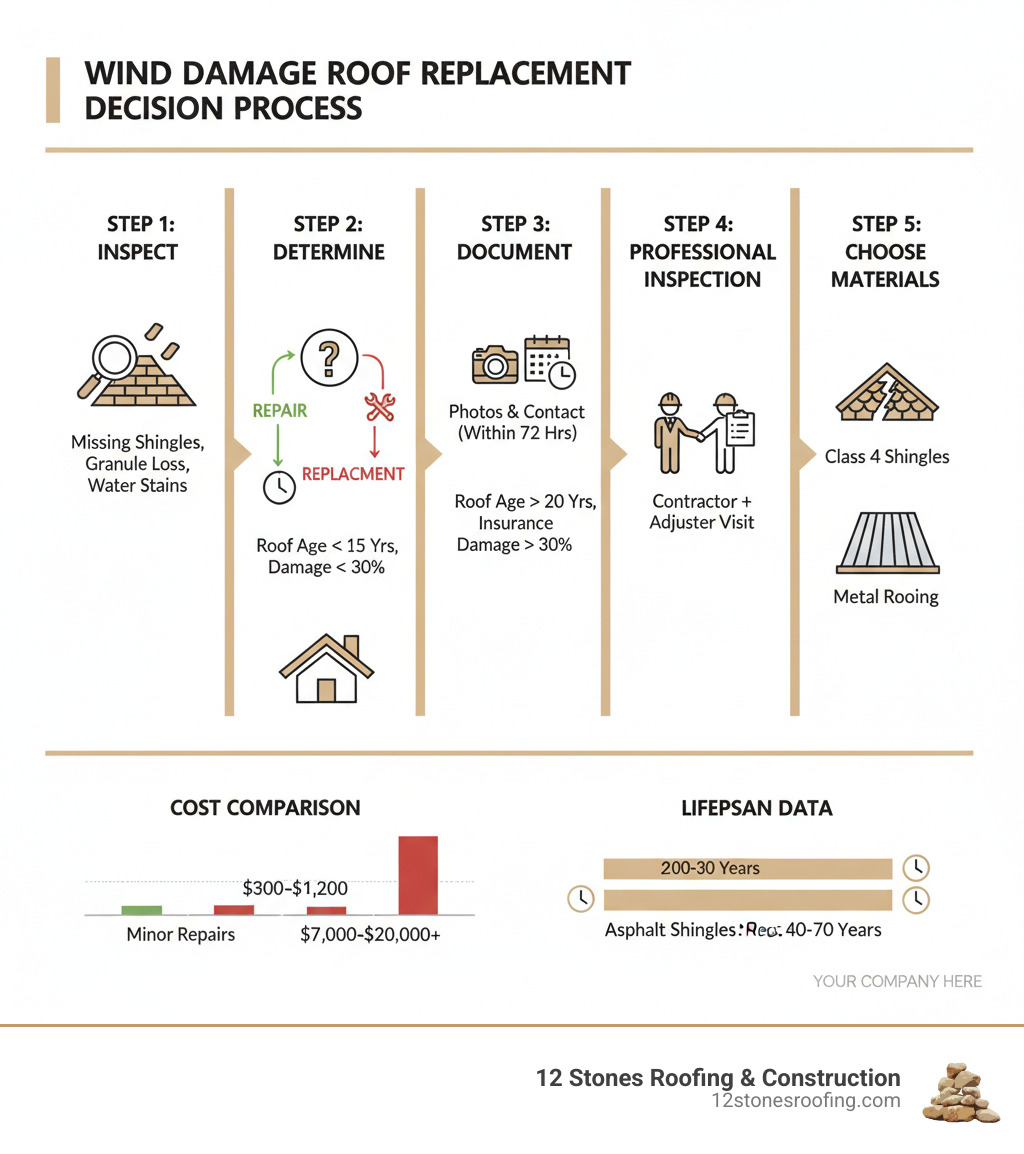
Step 1: How to Identify and Assess Wind Damage on Your Roof
After a storm, a thorough and safe assessment is the most critical first step. Never climb on a wet or unstable roof. You can spot most signs of damage from the ground. What looks like a few loose shingles might be widespread lifting underneath, and these hidden issues can lead to wood rot, mold, and structural damage if not addressed quickly.
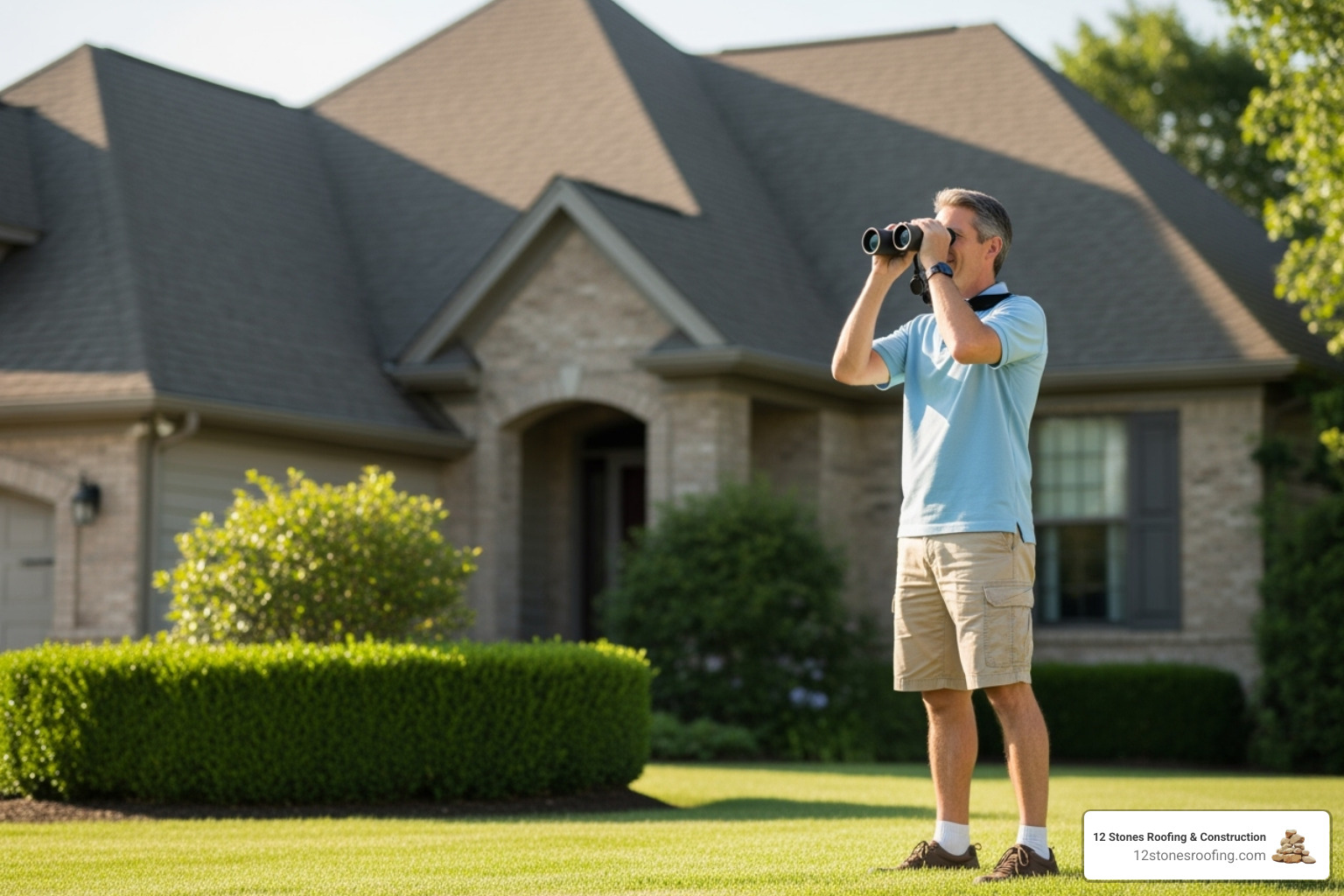
Common Signs of Wind Damage
Wind damage often appears in subtle ways. The most common indicator is lifted, creased, or missing shingles. When wind breaks a shingle’s adhesive seal, it compromises your roof’s water resistance. Another key sign is a collection of asphalt granules in your gutters. These granules are the shingle’s protective layer; when they’re stripped away, your roof becomes vulnerable to UV rays and deteriorates faster. Inside your home, look for water stains on ceilings or walls and musty odors in the attic, which signal a breach in your roof’s integrity.
Damage Across Different Roofing Materials
Not all roofs respond to wind the same way. The material determines the type and severity of damage.
- Asphalt shingles, common in Pasadena, are vulnerable to wind uplift, which can peel them back or tear them off completely. Creasing and granule loss are also frequent issues.
- Metal roofing is highly durable but not invincible. Wind-borne debris can cause dents, and strong gusts can lead to panel uplift if fasteners fail.
- Tile roofs can suffer from cracked, chipped, or dislodged tiles. Flying debris can shatter them, and damage is not always obvious from the ground.
Your Post-Storm Assessment Checklist
Use this systematic approach to safely check your roof after a storm:
- Ground-Level Visual Check: Walk around your home and look for missing, bent, or lifted shingles. Note any dark patches where granules may have been scoured away.
- Attic Inspection: Use a flashlight to look for water stains on the underside of the roof deck, on insulation, or any visible daylight peeking through.
- Document Everything: Take clear photos of any damage from multiple angles. This documentation is crucial for insurance claims.
- Check Gutters and Downspouts: Look for an unusual accumulation of granules, which is a major red flag for shingle damage.
- Inspect Vents and Flashing: Check for bent, lifted, or detached flashing around chimneys, skylights, and vents, as these are common failure points.
- Schedule a Professional Inspection: A trained inspector can identify subtle problems like loosened seals and hidden punctures that are invisible from the ground. This proactive step is the smartest investment you can make after a storm.
Step 2: Repair or Replace? Making the Right Decision for Your Wind-Damaged Roof
After assessing the damage, you face a critical question: repair or replace? This decision impacts your home’s long-term protection and your finances. While a few missing shingles on a newer roof may only require a simple repair, widespread issues often make a full wind damage roof replacement the smarter investment. The choice depends on three factors: roof age, damage extent, and long-term cost-effectiveness.
| Criteria | Roof Repair | Roof Replacement |
|---|---|---|
| Cost | Lower upfront (typically $300-$1,200) | Higher upfront (avg. $8,500, can be $10,000+) |
| Lifespan | Short-term fix, extends life of existing roof | Long-term solution (new lifespan of 20-50+ years) |
| Warranty | May void existing, limited new warranty | New manufacturer and workmanship warranty |
| Property Value | Minimal impact, maintains existing value | Increases home resale value and curb appeal |
| Insurance | Less likely to cover minor damage fully | Often covered for major storm damage (RCV policies) |
When to Choose Roof Repair
Repair is often the best choice if your roof is relatively young (less than 10-15 years old) and the damage is confined to a small, specific area. For example, if a storm loosened a dozen shingles on one corner of an otherwise solid roof, a targeted repair can restore protection without the expense of a full replacement. Minor, localized damage—like a small section of lifted shingles or a puncture from a branch—is the ideal scenario for a repair, which typically costs between $379 and $1,755.
However, a repair is a temporary solution. It extends the life of your existing roof but does not reset its overall lifespan.
When a Full Wind Damage Roof Replacement is Necessary
Replacement becomes the clear choice when repairs no longer make financial or structural sense. The most common guideline is the 30% rule: if more than 30% of your roof is damaged, replacement is almost always the better investment. This level of damage is common after severe weather with hurricane-force winds (74+ mph) that cause widespread shingle loss or structural compromises.
Age is a critical factor. If your asphalt shingle roof is nearing its 20-year lifespan, even minor wind damage can signal systemic failure. The adhesives weaken, granules wear thin, and the entire system becomes brittle. Patching an old roof is like putting a band-aid on a broken bone—it doesn’t solve the underlying problem. Red flags that demand replacement include a sagging roof deck, frequent leaks in multiple areas, or visible daylight through the attic.
Understanding the Costs: Repair vs. Replacement
A minor repair might cost between $379 and $1,755. In contrast, a complete roof replacement averages around $8,500 and can exceed $10,000 depending on the roof’s size and materials. While the upfront cost is significant, a replacement is a long-term investment that provides:
- A new warranty covering materials and workmanship for 20-50+ years.
- Increased home value and curb appeal.
- Reduced future costs by eliminating the cycle of frequent repairs.
- Superior protection with modern, wind-resistant materials.
Investing in a new, resilient roofing system is often the smarter long-term play compared to repeated repairs on an aging roof.
Step 3: Navigating the Insurance Claim Process for a Wind Damage Roof Replacement
Your homeowners insurance is designed for storm damage, but the claims process can be overwhelming. Understanding your policy and following the correct steps are key to a successful claim for a wind damage roof replacement.

Does Homeowners Insurance Cover Wind Damage?
Most standard homeowners policies cover wind damage. However, the payout depends on your policy type:
- Actual Cash Value (ACV): Pays the depreciated value of your roof, accounting for age and wear. You will have to cover the difference for a new roof out of pocket.
- Replacement Cost Value (RCV): Covers the full cost of replacing your roof with new, similar materials. This is the more favorable policy for homeowners, as it minimizes out-of-pocket expenses.
Claims for sudden, accidental wind damage are typically covered. However, insurers may deny claims if they determine the damage resulted from poor maintenance, old age, or faulty installation.
A Step-by-Step Guide to Filing Your Claim
Follow these steps to streamline your insurance claim:
- Document Everything: As soon as it’s safe, take detailed photos of all visible damage from multiple angles. Include interior leaks, water stains, and collateral damage to gutters or siding.
- Contact Your Insurer Immediately: Policies often have strict time limits for filing. Initiate the claim process promptly and provide your initial documentation.
- Get a Professional Inspection: Before the adjuster arrives, have a trusted roofer conduct a comprehensive inspection and provide a detailed estimate.
- Have Your Contractor Present for the Adjuster’s Visit: This is critical. An insurance adjuster may not be a roofing expert and can miss subtle damage. Your contractor can advocate for you, point out all identified issues, and ensure the scope of work is accurate.
- Review the Adjuster’s Estimate: Compare the insurer’s estimate with your contractor’s. We can help you identify any discrepancies and supplement the claim to ensure you receive fair compensation.
- Proceed with Work: Once the claim is approved, we will perform the replacement, handle the paperwork, and ensure all work meets code to secure the final insurance payment.
If you have questions about your policy or need help navigating a claim, give us a call at (281) 702-8680. We have helped hundreds of homeowners secure the coverage they deserve.
Step 4: Proactive Protection: How to Prevent Future Wind Damage
The best way to handle wind damage is to prevent it. Proactive measures can significantly strengthen your roof’s ability to withstand the severe weather common in the Pasadena area.
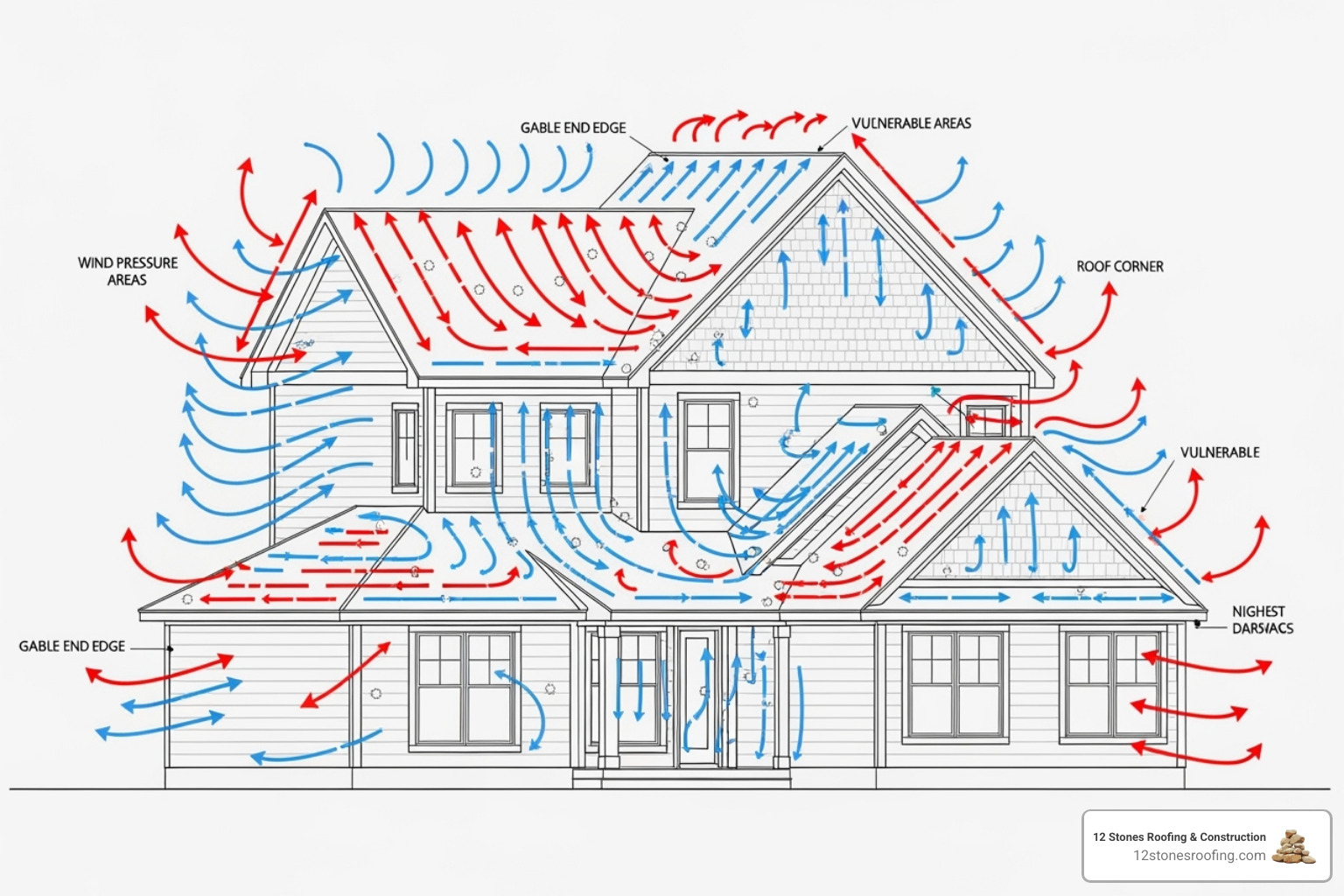
Choosing Wind-Resistant Roofing Materials
When it’s time for a replacement, upgrading to materials engineered for high-wind environments is a smart investment.
- Class 4 impact-resistant shingles are built with a reinforced mat and stronger adhesives to withstand high winds and hail. Many insurance companies offer premium discounts for installing them.
- Metal roofing offers exceptional longevity (40-70 years) and durability. Properly installed panels are securely fastened to resist wind uplift and debris impact.
Beyond materials, the installation method is crucial. Following best practices, such as those outlined by FEMA for minimizing wind damage, includes using extra fasteners and ensuring proper sealing at all edges and penetrations where wind can cause uplift. You can read more in FEMA’s Best Practices for Minimizing Wind and Water Infiltration Damage.
Essential Roof Maintenance Tips
Regular maintenance is your first line of defense against needing a future wind damage roof replacement.
- Perform Routine Inspections: Visually inspect your roof twice a year (spring and fall) and after every major storm. Check for loose shingles, debris, and signs of leaks in the attic.
- Keep Gutters Clear: Clogged gutters cause water to back up under shingles, leading to rot. Clean them at least twice a year to ensure proper drainage during wind-driven rain.
- Trim Overhanging Trees: Remove limbs that could fall and damage your roof during a storm. This simple step prevents punctures and abrasions from high winds.
For a more detailed guide, check out our Roof Maintenance Checklist. These proactive steps can extend your roof’s lifespan and save you thousands in potential repairs.
Frequently Asked Questions about Wind Damage Roof Replacement
After a storm, homeowners have many questions. Here are answers to the most common concerns about wind damage.
How much wind does it take to damage a roof?
Wind speeds of just 40 mph can begin to lift and crease shingles, breaking their adhesive seal. This is especially true for older or improperly installed roofs. While you don’t need a hurricane to sustain damage, the risk increases significantly with wind speed. Gale-force winds (39-54 mph) can cause visible damage, and once winds reach hurricane-force (74 mph or more), widespread, severe damage is a real possibility.
Can I replace just part of my roof?
Yes, a partial replacement is possible for localized damage and can be a cost-effective solution if the rest of your roof is in good condition. However, there are two main challenges. First, matching the color and texture of new shingles to older, weathered ones is often impossible, resulting in a patchwork look. Second, a partial replacement creates new seams that could be vulnerable to future leaks if not installed perfectly. We can help you determine if a partial repair is a viable long-term solution for your home.
What are the long-term consequences of ignoring minor wind damage?
Ignoring what seems like minor damage is one of the costliest mistakes a homeowner can make. Over time, small issues lead to severe consequences:
- Water Damage: A single lifted shingle can allow water to seep in, causing wood rot in the roof deck and rafters. This moisture can travel, damaging ceilings, walls, and insulation.
- Mold and Mildew: Persistent moisture creates a breeding ground for mold in your attic and walls, which poses serious health risks and requires expensive remediation.
- Higher Energy Bills: A compromised roof leads to poor insulation, forcing your HVAC system to work harder and increasing your monthly utility costs.
- Accelerated Aging: What could have been a simple repair can quickly snowball, leading to the premature need for a full roof replacement and potentially voiding your manufacturer’s warranty.
Promptly addressing wind damage, no matter how small, saves you money and protects your home in the long run.
Conclusion: Secure Your Home with a Trusted Pasadena Roofing Expert
After a storm, your priority is to secure your home and restore your peace of mind. A prompt, honest assessment from a professional is the first step. By understanding the choice between repair and replacement, navigating your insurance claim with an expert, and investing in preventative maintenance, you can protect your property from future threats.
Choosing a reliable, local contractor who understands the unique challenges of the Southeast Texas climate is your most important decision. At 12 Stones Roofing & Construction, we provide honest assessments and superior workmanship. If a simple repair is all you need, we’ll tell you. If a wind damage roof replacement is the smarter investment for your home’s long-term safety, we’ll explain why and guide you through the process.
If you suspect your home has suffered wind damage, don’t wait for a small problem to become a disaster. Contact our Pasadena roofing specialists today for a comprehensive, no-obligation inspection. Let’s get your roof—and your peace of mind—back where it should be.



